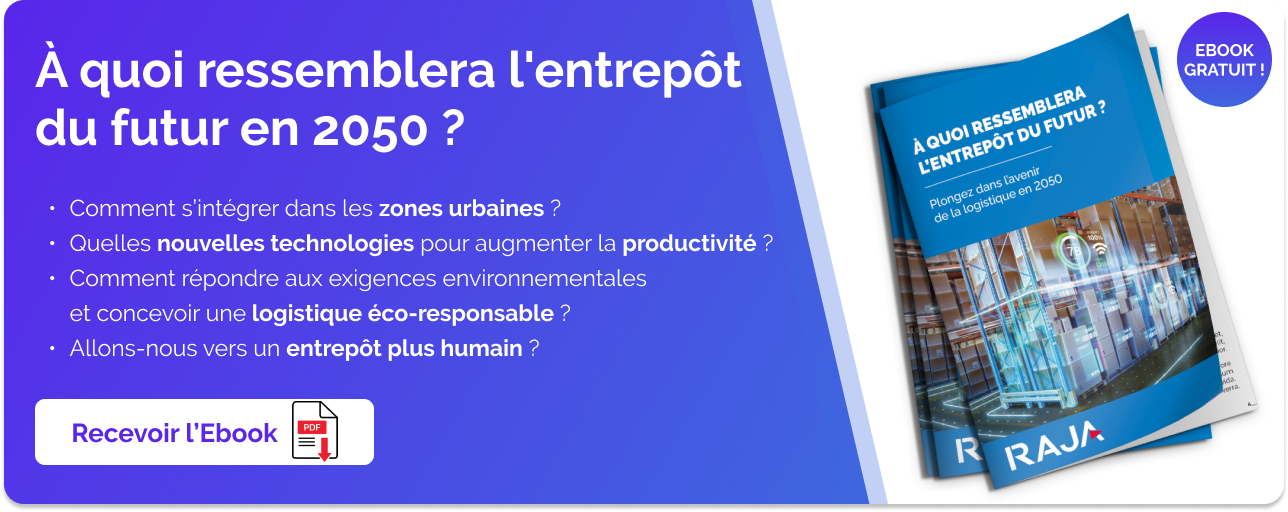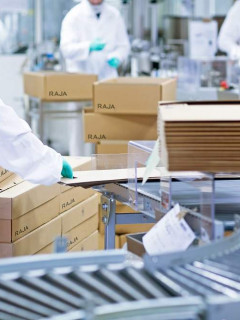At a time when teleworking has become a permanent feature of business life, many companies continue to take care with the layout of their business offices. And with good reason: it’s a key factor in productivity, as well as attractiveness!
To delve deeper into this subject, we interviewed Thomas Damame, Furniture Group Manager at JPG, who gave us his 10 best practices when it comes to fitting out business premises. At the end of the article, you’ll also find some tips on how to optimise the layout of your warehouse.
| Who is JPG?
JPG, a subsidiary of the RAJA Group, is a specialist in the fitting out of business premises, offering both distance selling of furniture to equip VSEs and SMEs, and a team enabling you to refit your entire workspace. JPG’s expertise covers all the needs of VSEs and SMEs, up to 200 workstations. |
Why take particular care when fitting out your business offices?
If you’re planning to fit out your business offices, you’re probably already aware of the first reason to take an interest: increasing productivity.
Well-designed offices allow companies to take into account the health of their employees, by offering them furniture that is adapted to the human beings they are. The idea is to avoid problems such as musculoskeletal disorders, carpal tunnel and neck pain, so as to improve their well-being within the company and limit absenteeism. RAJA explains how to prevent RSI.
But we often overlook the impact that office design has on the employer brand, and therefore on attracting new talent. A warm welcome, attractive furniture and attractive premises are all signs of a company’s economic, cultural and social health – especially for the younger generation! In short, what you see on the inside is reflected on the outside.
| “It’s crucial for any business not to neglect office furniture in the broadest sense. The design of the workspace is as essential as having a good PC that works well! It’s what reflects the company’s image, its need and desire to please, and to take care of its employees”.
Thomas Damame, Furniture Group Manager at JPG |
10 best practices for fitting out your business offices
Now that you’re aware of the benefits of a well-designed business office, check out these 10 practical tips for carrying out your own project successfully.
1. Study your business to find the right furniture for it
Having the right professional office furniture means first and foremost taking an interest in the jobs themselves. The idea? Study the different workstations to find the right furniture for them, and not just for the company as a whole, to make them more productive and make their work easier.
In particular, your furniture should optimise circulation and the various exchanges between individuals who need to work together. For example, placing a half-moon-shaped element at the end of a table for short meetings at the workstation itself (with graphic designers, for example) can be a significant plus.
2. Think ergonomics
Ergonomics is the keystone of a successful professional office design project. The principle is simple: find the layout and furniture that limit discomfort and adapt to your employees’ bodies.
To achieve this, one of the first components is of course the desk. Positioning a screen support arm, a wrist support, an ergonomic mouse, a footrest that moves, or even offering a sit-stand desk, all help to ensure optimal posture and limit posture-related pain.
Don’t hesitate to opt for furniture that allows employees to move around or change position. For example, innovative seating shapes such as balloons or desk bicycles can be interesting to position in the middle of an open-plan office.
3. Redesigning offices, but also other areas of the premises
Whether you’re redeveloping existing offices or embarking on a brand new project, make sure you also encourage third-party spaces on your premises.
In particular, take care to fit out :
- An original break room, ideal for relaxing and sharing
- Optimal meeting spaces, with electrified tables adapted to computer equipment, and with more dynamic, moving seating
Other features, such as acoustic booths to give your staff a sense of seclusion, can also have the greatest effect on your talent, making them want to come into the office and be highly productive.
| “For some years now, we’ve been paying more attention to the furniture that makes it possible to hold meetings or take a break properly, with warm, more “home” style furniture. Aside from aesthetics, we’re also seeing the emergence of user-friendly elements such as table footballs, Fatboy-type footstools and even arcade terminals in business premises.”
Thomas Damame, Furniture Group Manager at JPG |
4. Don’t neglect lighting
Did you know? There is a European standard which recommends that each workstation should have 500 Lux, in order to avoid eye problems. Unfortunately, this standard is very often neglected.
So remember this: putting an adjustable table lamp in a workspace isn’t just for “looks”! Brightness has an impact on employees’ moods, and it’s a big productivity booster. The idea is to take into account the circadian rhythm when adjusting brightness in offices.
| “Your employees need lighting that adapts to their mood, but also to their physiological needs. For example, in the morning, people often prefer a warm, less intense colour. In the morning, for example, we often prefer a warm, less intense colour, then we’ll switch to a high intensity brightness and a white colour when we’re concentrating a lot.
Thomas Damame, Furniture Group Manager at JPG |
5. Taking care of the acoustics
After light, it’s time for sound: managing the acoustics in your premises is crucial, not only to ensure real productivity, but also to promote well-being in your offices.
For example, installing screen panels between the different workspaces in an open-plan office not only delimits the space between them, but also optimises the overall acoustics of the office.
6. Choose your furniture according to the associated electronics
Today,electronics are everywhere – and the design of your professional offices needs to take this into account from the outset.
Think about investing in connected products such as connected screens or touch screens: these are all tools that can simplify computer work. In the same way, there is connected furniture, but also furniture where it is possible to plug in easily, thanks to plug-in units placed on meeting tables, on flex office desks or in pedestals.
This furniture needs to be designed for the workspace, but also for third-party spaces. For example, why not offer tables where employees can recharge their mobile phones during lunch or breaks?
7. Pay attention to eco-responsibility when fitting out professional offices
It’s a fact: your employees are becoming increasingly aware of eco-responsibility in all areas of their lives, both personal and professional. So when it comes to fitting out your business offices, you need to look at environmentally-friendly solutions.
Especially as the AGIEC law requires you to do so! Since February 2022, this legislation has made it compulsory to take back old office furniture. What’s more, public-sector companies must make 20% of their purchases from upcycled or second-hand products; and this rule will be extended to the private market, probably in 2025.
The Climate and Resilience Act also includes a facet concerning the design of your premises. It says that by 2025, all manufacturers and distributors will have to have a product rating for furniture (both home and office).
All good reasons to choose furniture that is sourced locally, or that participates in the community system, for example.
| “At JPG, 98% of our products are certified, NF environnement, FSC, PEFC… We pay particular attention to eco-responsibility when choosing our suppliers and their products, which is a strong value at JPG.”
Thomas Damame, Furniture Group Manager at JPG |
8. Applying the “At home as well as at the office” trend
What if you also thought about the design of your premises when fitting them out or refitting them? The current trend in terms of the design of professional spaces is “Home from the office”: the fact that the personal home and its design are being incorporated into professional premises.
Business furniture used to be very white. Nowadays, we tend to see wood decors, with oak and grained wood, with a more decorative, warm and natural look, taking over the premises. Rounded shapes and bright colours are also the order of the day.
In terms of design, think about :
- Highlight thecompany’s graphic charter in the furniture itself
- Choose colours that have a positive influence on employees’ moods: a blue meeting room to encourage creativity, red screen panels to stimulate concentration, yellow to help decision-making, etc.
- Ensure thatthe décor of your premises isconsistent
| “The attractiveness of the furniture is crucial. You have to be able to offer spaces that appeal – especially after Covid, when you have to make employees want to come back to the company!”
Thomas Damame, furniture group manager at JPG |
9. Green spaces
Did you know that a study has shown that the sight of a plant, even an artificial one, in a workspace leads to fewer sick days in the company?
When it comes to furnishing your premises, the outside can also come inside, thanks to the use of plants. Plants are not just an accessory: they are necessary for healthy employees who enjoy working, and give the company a good, serene image.
10. Take teleworking into account
Teleworking has become a permanent feature in most companies – and your business office design project should take this into account. As a company, you are also responsible for the furniture you provide for your employees!
During the Covid, your employees felt the effects of non-ergonomic furniture on their health and motivation. Hence the need to offer them, at the very least, an ergonomic chair, as well as a few key elements to ensure their comfort when teleworking.
| “A final word of advice? Get help with your professional office design project. You can’t just improvise an office fit-out. The aim is to understand the needs of the company and its employees, to visit the current premises, to see how people work, to ask questions… After that, you’ll get advice on how to place the furniture and people differently. Take it one step at a time, depending on your budget. Even if you can’t apply all the best practices at once, it’s crucial to take into account the well-being and ergonomics of your employees little by little.”
Thomas Damame, Furniture Group Manager at JPG |
Top tips and products for fitting out your warehouse
As well as fitting out your business offices, are you also planning to reorganise your warehouse? Here are the key tips from our RAJA experts for optimising your warehouse through layout.
- Choose a storage method suited to your activity. This is the basis for the subsequent layout of your warehouse, particularly in terms of racks and aisles.
- Comply with the safety standards appropriate to your business. Think in particular about the standards in terms of ventilation, waste water treatment, emergency exits, dedicated lanes for machinery, etc. To find out more, see our article on the subject.
- Install appropriate signage. While floor marking tapes can be used to demarcate the different lanes and spaces in your warehouse, signs help you to indicate emergency or evacuation zones, as well as safety instructions.
- Make the most of the space available as soon as possible, with mezzanine units, self-supporting structures or by reducing the width of aisles.
- Choose the right shelving for your goods. They must be adapted to your type of product, its weight and the storage method you have chosen. Take a look at the different stages in choosing your shelving here.
- Think about ergonomics and well-being in the warehouse. Optimise your workstations with ergonomic workstations, sit-stand stools and anti-fatigue mats. The handling machines you choose also have a decisive role to play in reducing drudgery in your warehouse: select them accordingly!
Now you’re ready to apply best practice in warehouse and office design, and to improve your employer brand and the QWL on your premises.
















